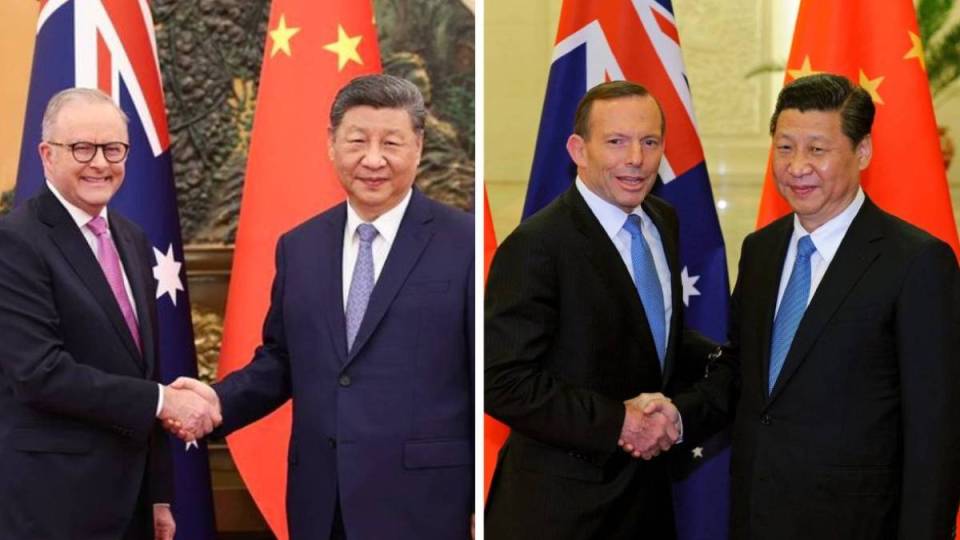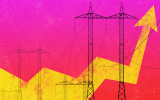


In some ways it’s good that the Prime Minister’s visit to China is over, since the risk of conservative politicians and their fellow travellers busting a poofle valve has abated.
Tony Abbott complained the PM’s visit was renewing Australia’s interest in great economic involvement in China “rather than reduce it … the more exposed to China we are the more vulnerable we are” and that the visit was “the wrong trip at the wrong time to the wrong place”.
Could this be the same Tony Abbott who, as prime minister, invited President Xi Jinping to address the Australian Parliament and sign a comprehensive strategic dialogue? And who, a year later, lauded his government’s free trade agreement with China that was initiated by John Howard and kicked along by me as trade minister and finalised by my successor, Andrew Robb?
Yet Victorian senator Jane Hume complained of Albanese making “fawning concessions on trade” (whatever they were) on his recent visit, while shadow finance minister James Paterson objected to Albanese’s “visit to Chengdu to pose with some pandas”.
If Paterson knew anything about Chengdu, he would acknowledge it is a global high-tech leader, host to such companies as Toyota, Motorola, IBM, Nokia, Siemens, Canon, Microsoft and Intel.

Yes, Chengdu has pandas. I know because when, as trade minister, I visited the city of 21 million people in 2011, a baby panda sat on my lap as I fed it watermelon. But that’s not why I visited. It was to lead an Australian business delegation in meetings with their Chinese counterparts.
And in 2013, I met newly appointed President Xi Jinping with prime minister Julia Gillard at the Boao Conference, whose creation was inspired by former prime minister Bob Hawke.
We then travelled to the Great Hall of the People to initiate the strategic dialogue that Abbott signed a year later.
Both these occasions paved the way for Abbott’s warm welcome to Xi in 2014.

A wise person described to me an approach that is effective in dealing with China – quiet diplomacy. It helped achieve the release of journalist Cheng Lei and it was deployed by Australia’s trade minister, Don Farrell, and other ministers in achieving the removal of China’s tariffs on Australian wine, barley, beef and lobster.
It was the Coalition’s megaphone diplomacy of the early 2020s that led to the imposition of these tariffs in the first place.
At the May federal election, the Coalition again paid a price for slagging off against China, having also done so during the 2022 election.
Australian Chinese voters might reserve the right to have their own opinion about China, but they don’t appreciate the Australian government attacking their homeland. It makes many of them feel the Liberal and National parties don’t trust them.
References to Labor minister Clare O’Neil using “Chinese spies” to staff her polling booths certainly didn’t help the Liberal Party’s cause.
And most Australians understand the importance of China as a trading partner. It buys more of our goods and services than the next four – Japan, Korea, the US and India – combined.
For reasons best known to themselves, Coalition MPs and their backers in conservative think tanks and the media consider they are on a winner by criticising Albanese’s visit to China – with all the hypocrisy it entails.
Where the Albanese government disagrees with China, the Prime Minister and his ministers choose to leave aside the megaphone and speak frankly.
Beyond the Coalition’s repeated deployment of the megaphone and its hyperventilating, it’s not obvious what its strategy is or seeks to achieve.
Craig Emerson is executive of the Australian APEC Study Centre at RMIT University and adjunct professor at Victoria University’s Centre of Policy Studies. He was Australia’s trade minister from 2010 to 2013 and architect of the White Paper on Australia in the Asian Century. He was trade adviser to prime minister Bob Hawke from 1986-1990










